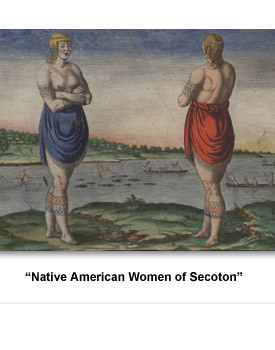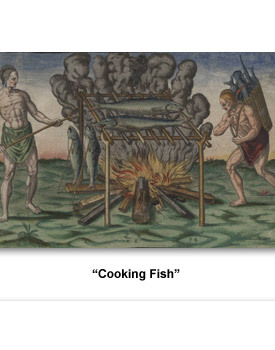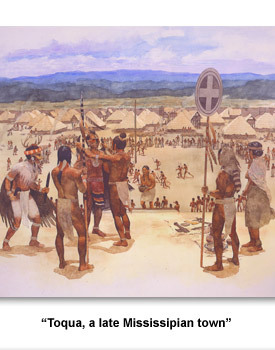Indians & Cultural Encounters
How They Lived
Tennessee was a land of rivers and forests, with mountains in the east giving way to prairie and river plains in the west.
The land influenced the development of Tennessee native peoples and shaped European contact. Native villages were usually on flat mountain meadows in the east and in river bends in the west. The land afforded a wide variety of plants and animals for food. There was also plentiful fertile land for agriculture.
Different tribes lived in each of the regions of Tennessee. The Cherokees lived in the mountainous east, and their territory extended into North Carolina, South Carolina, Georgia, and Alabama.
Both the Cherokees and Chickasaws claimed parts of Middle Tennessee as hunting grounds. While the Chickasaws were not a large tribe in the state, they were good at fighting. There were armed conflicts between the two tribes.
The Shawnees also lived in the area around what is now Nashville for a short time in the eighteenth century.
The Shawnees also lived in the area around what is now Nashville for a short time in the eighteenth century.
The Chickasaws claimed parts of West Tennessee in the Mississippi Valley. Early French explorers also referred to other “small tribes,” but who they were, where they lived, and what happened to them is not known today.
Picture Credits:
- “Toqua, a late Mississipain town,” circa AD 1450. Life size mural by Greg Harlin. This contemporary painting represents how the artist thought a typical village scene might have looked. Toqua was an Overhill Cherokee village located on the Little Tennessee River. The Mississippian period in Native American history is from 1000 to 1600 AD. This picture depicts town leaders assembled on a summit mound for “Busk,” a four to eight day ceremony that celebrated the New Year. A stick ball game is also shown, with spectators watching and socializing. Residential structures are pictured in the background. The scene is based on research from the Monroe County, Tennessee, excavation site. Courtesy of the Frank H. McClung, University of Tennessee.
- Print entitled, “Cooking Fish.” This picture depicts two Indian men cooking fish over an open fire. Originally drawn by John Whyte this picture was originally included in the book A Briefe and True Report of the New Found Land of Virginia by Thomas Hariot. Later the image was engraved by Theodor de Bry and reprinted in 1590. The men pictured belong to the Southern Algonquian group of Indians and are related to the Shawnee. North Carolina Collection, University of North Carolina.
- Print entitled, “Native American Women of Secoton.” This double portrait shows a Native American woman wearing a cloth skirt standing in front of a coastal scene. Originally drawn by John Whyte this picture was originally included in the book A Briefe and True Report of the New Found Land of Virginia by Thomas Hariot. Later the image was engraved by Theodor de Bry and reprinted in 1590. De Bry wanted to make Native Americans look more like Europeans, so he drew them with blonde hair and white skin. Although the drawing is not entirely accurate, it demonstrates how some Europeans did not understand or appreciate the ways in which Native Americans were different from them.The men pictured belong to the Southern Algonquian group of Indians and are related to the Shawnee. North Carolina Collection, University of North Carolina.
Indians & Cultural Encounters >> Indian Life >> How They Lived >>



 Sponsored by: National Endowment for the Humanities
Sponsored by: National Endowment for the Humanities